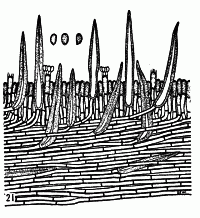|
 Hymenochaete stratura Hymenochaete stratura
BiostatusPresent in region - Indigenous. Endemic
Images (click to enlarge)
Caption: FIG. 21. Hymenochaete stratura G.H.Cunn. Transverse section x 500; spores x 1000.
Showing intermediate tissue composed of parallel cemented hyphae embedding a few setae. |
Article: Cunningham, G.H. (1957). Thelephoraceae of New Zealand. XIV. The genus Hymenochaete. Transactions of the Royal Society of New Zealand 85(1): 1-51.
Description: Hymenophore resupinate, annual, waxy, brittle, adnate, at first appearing as numerous
scattered colonies 2-10 mm diameter, merging to form linear areas to 12 x 3 cm. Hymenial
surface at first cinnamon, becoming ferruginous or umber, deeply creviced with edges lifting
to expose the substratum, colliculose, velutinate; margin thinning out, fulvous, later
concolorous, fibrillose, loosely attached, finally lifting and curling upwards or inwards.
Context ferruginous, 70-160 µ deep, composed of an intermediate tissue of parallel densely
compacted cemented hyphae turning abruptly into the hymenial layer; hyphal system
monomitic; generative hyphae 2.5-3 µ diameter, walls 0.25-0.5 µ thick, reddish-brown,
sparsely branched, septate. Setal layer to 90 µ deep, of 2-3 vague rows (often confined to one)
of overlapping setae arising in the subhymenium; setae projecting to 35 µ, subulate, often
angled near the base, 35-65 x 5-7 µ, walls naked, reddish-brown, lumina narrow or broad.
Hymenial layer to 25 µ deep, a close palisade of basidia and paraphyses, tinted below. Basidia
subclavate, 12-14 x 4-4.5 µ, 4-spored; sterigmata upright, slender, to 4 µ long. Paraphyses
subclavate or cylindrical, shorter and slightly narrower than the basidia. Spores suballantoid,
3-3.5 x 2-2.5 µ, walls smooth, hyaline, 0.1 µ thick.
Habitat: HABITAT: Effused on bark of dead branches associated with a white rot.
Distribution: DISTRIBUTION: New Zealand.
Notes: Separated from other species of the section by the densely compacted, cemented, narrow
parallel hyphae forming the intermediate layer, small spores and setae, and surface features.
Young plants are scattered, orbicular with fulvous, fibrillose, loosely attached margins. When
dry plants become brittle, margins lift and become incurved or erect, and edges of crevices
curl upwards to expose the substratum. Spores are small and vary somewhat in shape; most
are suballantoid, some narrowly elliptical or obovate. The taxad hosts may provide an aid to
identification if later collections show the species to be confined to these.
|